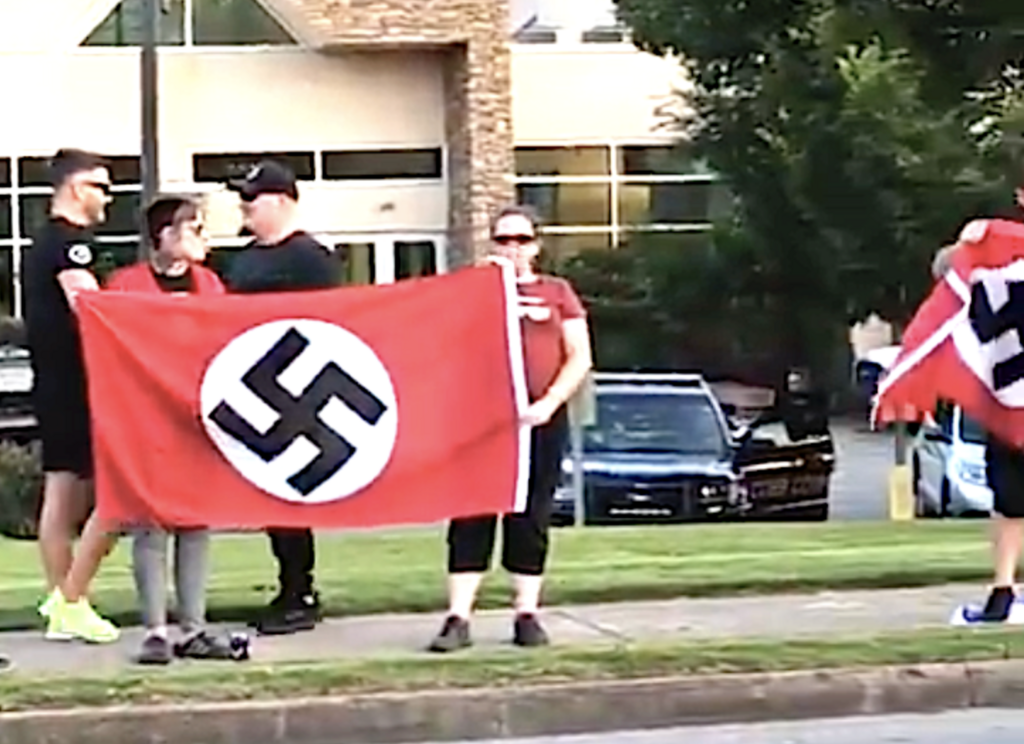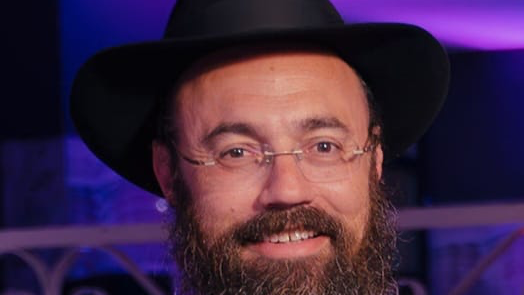Getting your Trinity Audio player ready...
For over 20 years, my community and I have gathered every Saturday morning to celebrate Shabbat services with singing, prayer, dancing and meaningful conversation. This past week was different. It was as I walked to Chabad for prayers that I first saw the horrific sight of the massive swastika flags. Instead of having a peaceful time to pray, we were disturbed by a group of agitators shouting antisemitic taunts and holding signs that promoted nasty anti-Jewish conspiracy theories.
More stories:
I cannot begin to describe the feelings of anger and outrage that this vile antisemitic hate evoked within me. Many of my relatives were gassed and burned in the Nazi death camps and seeing this despicable group rally outside a Jewish house of worship in 2023 was extremely disturbing. Thankfully, I was familiar with this particular group – which came from out of town – and their tactics of provoking the Jewish community into being their unwitting megaphone. I was able to compose myself and instead focused on leading the Shabbat prayers and Torah class.
2 View gallery


Goyim Defense League protests Chabad of Cobb in Georgia with Nazi flags
(Screenshot, YouTube)
In the hours after the protest, I began to formulate a response. I am aware of the traditional response of expressing outrage, condemnation and hand-wringing statements about rising antisemitism. However I am also aware that these statements leave the Jewish community feeling scared, vulnerable and in dread of the future. Experience has taught me that there is a better approach - one I had experimented with previously.
My teacher and mentor was the Rebbe – Rabbi Menachem M. Schneerson, of righteous memory. He taught that the most effective response to darkness is to transform it into light. To use the experiences of hatred and negativity as opportunities to inspire more positivity
Last March, photos circulated of East Cobb middle school students wearing swastika armbands and giving the Nazi salute. There was plenty of condemnation and hand-wringing, but after the initial outrage I wanted to transform this dark incident to a teachable moment which could spread light.
So I sat down with these middle school students and their parents to educate them about antisemitism. l shared the story of my grandmother, a Holocaust survivor, and showed them a Holocaust documentary. I helped them understand that the genocide of 6 million people is not a matter that anyone should make a mockery of. There were plenty of tears and remorse, but I knew that we also needed to find a way to transform their ugly actions into something positive.
After learning that some of these kids were musicians, united by their shared love of music and their newfound appreciation of the sensitivities of the Holocaust, the kids joined five Jewish classmates to form a band. This group performed at an assisted-living facility and brought tremendous joy to the seniors who lived there. They were able to turn an instance of hate and darkness into an opportunity to spread light.
In a similar vein, I wanted to issue a response to the antisemitic incident that took place in front of our Chabad last week.
There needed to be condemnation – which I received plenty of help from thousands of people on social media – but there also needed to be a message of hope and positivity, and one of transforming this darkness into opportunities for light.
First, we focused our messaging on the following three points:
1. The vast majority of our country is loving, kind and respectful of the Jewish people. This is a small fringe group and their hatred should not taint the way we see our neighbors, our East Cobb community and humanity in general.
2. The response of the wider community needs to be to combat the hate with more acts of love and kindness
3. The response of the Jewish community to this darkness needs to be more light in the form of even greater Jewish pride and engagement
The results of this approach have been remarkable. The message has left our Chabad community feeling proud empowered and optimistic. However, beyond our own community, the positive nature of our message has also led to a greater response from the wider non-Jewish community. In the words of one of my colleagues: “This is the first time I can remember that the Jewish community has not needed to form its own response to an antisemitic incident."
Following last Saturday’s incident, I saw an unbelievable outpouring of love and support. Lawmakers condemned the hateful actions and proposed bills combating antisemitism. I received over 1,000 emails and phone calls from across Georgia and the US expressing love, solidarity and support. Residents from our neighborhood decorated the area outside our synagogue with signs bearing the sentiments: “We love you,” “No to Antisemitism” and “God Loves You.”
In contrast to the tiny minority of people espousing hate, we were warmly embraced by the 99%. Georgia State Rep. Brent Cox, a personal friend and Evangelical Christian, said of the incident: “How could they do this to my synagogue?” This showed what I believe to be America’s true colors – that the majority of people have love and respect for our community and aren’t afraid to come to our side when we need them.
The neo-Nazis thought that their demonstration would rouse hatred among their fellows, and fear among the Jewish community. Instead, they have found themselves increasingly condemned and ostracized, while the Jewish community feels empowered, optimistic and inspired. When confronted with hate, we are doubling down on acts of kindness, love and Jewish pride.
Rabbi Ephraim Silverman is the director Chabad of Cobb
First published: 23:46, 07.02.23


